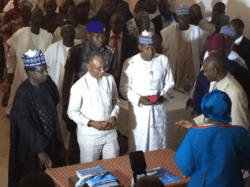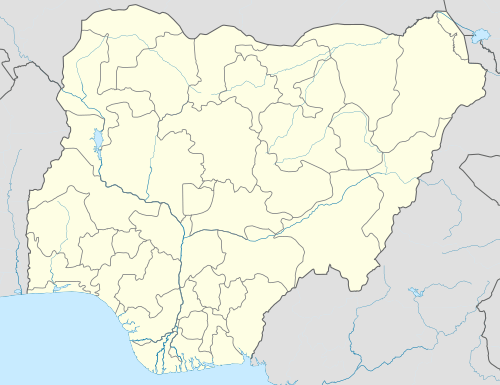Kafanchan
Kafanchan (Fantswam: A̠byin Fantswam; Nikyob: Manɡyanɡ) is a mainly Christian-dominated town in the southern part of Kaduna State, Middle Belt, Nigeria. It is the location of a junction station of the Nigerian Railway Corporation,[2] and it sits on the line connecting Port Harcourt, Enugu, Kafanchan, Kuru, Bauchi, and finally Maiduguri.[3] As of 2007, Kafanchan had an estimated population of 83,092.[4]
Kafanchan A̠byin Fantswam | |
|---|---|
Town | |
 Governor of Kaduna State, Nasir El-Rufai and Governor of Plateau State, Simon Lalong sign the Kafanchan Peace Declaration as official observers | |
| Nickname(s): Kaf City | |
 Kafanchan | |
| Coordinates: 9°34′N 8°18′E | |
| Country | |
| State | Kaduna State |
| LGA | Jema'a |
| Government | |
| • Executive Chairman/Mayor (Local Government Area) | Hon. Peter Danjuma Averik[1] |
| Elevation | 739 m (2,425 ft) |
| Time zone | UTC+1 (WAT) |
Etymology
James (2000) asserted that the indigenous inhabitants of the Kafanchan town and environs, the Fantswam people (who speak a dialect of Tyap), added the prefix "kwa" to all names of peoples and places, hence, the phrase, "kwa Fantswam". However, the Hausa immigrant elements who interacted with them found it more convenient to pronounce the phrase, kwa-Fantswam, as Kafanchan.[5]
The town developed as a result of British colonial commercial activities, i.e. a railway junction town in the early 20th century.
This fact brings another claim as to how the name Kafanchan came into existence. It was said that the name originated during the Nigeria railway construction period in the 1920s, when the railtrack crossbars were being laid, the white man would say in Hausa "kafachan", meaning leg there, i.e. 'put your leg there', then a crossbar would be laid after the labourer widens his leg, pushing a leg forward. Hence, the name Kafanchan.
People
Kafanchan was originally inhabited by the Fantswam people, who migrated from Mashan and located on present-day Atyap land, when they saw an elephant around the Ni̱mbyia̱ (Nimbio) forest and shot it with a spear, causing it to flee into the forest. Being hunters, they pursued it until they met where it fell within the plains. They finally settled there and became the aboriginal inhabitants of the present day Kafanchan plains.
A wave of migration caused by human and environmental factors such as the Fulani Jihad and famine caused other kin sub-groups such as the Nikyob (known as Kaninkon by the Hausa), the Bajju and the Atyap (Proper) to settle among the Fantswam. The Fantswam received them with open arms.[6] The Hausa-Fulanis also came and settled among the Fantswam, after they were driven from Kajuru by the Kajuru chief in the early years of the Fulani Jihad of the early 1800s. Usman Yabo led his people from Kajuru to settle in a place they named Jama'a Dororo meaning "people of Dororo" and founded an emirate amidst the people who gave him and his people the portion of land where they stayed, south of Fantswam territory. Yabo's descendant, the Hausa-Fulani ruler, Muhammadu, moved his capital to the heart of the Fantswam land in 1933, after the formation of the Plateau province in 1926.[7][8] This was done with the support of the British colonialists. Since neither the Fantswam nor their neighbouring kins had monarchs, the British colonialists on arrival in the 1900s, made the ruler of the Hausa-Fulani settlement emir of the surrounding area. The Hausa-Fulani named the area originally called Jama'a Sarari, a Hausa-Arabic phrase meaning "people of the plains". The Jama'an emirate was a vassal state of the Zaria emirate.[9]
On completion of the railway line linking the Kaduna station with the Kuru and the Port Harcourt railway stations, Kafanchan again experienced a heavy influx of the Igbo people from Nigeria's southeast. Many of these people left before the Nigeria Civil War in 1967, although some later returned. Yorubas from the southwest also came and settled in considerable amounts in the expanding town.
After the death of the emir of Jama'a in 1998, there were resentments to the turbaning of his son as the next emir. In 1999, the son of the late emir was unpopularly turbaned, leading to a public uprising in Kafanchan.
The Southern Kaduna indigenous people of the area, under the auspices of the Indigenous People of Jema'a (ICJ) responded to the turbaning by filing a suit against the Kaduna state government at the Kafanchan High Court. The Southern Kaduna people clamoured for the scrapping of the emirate system on their soil, as it was an alien institution imposed on them by the British colonialists.[10] A result could not be ascertained until the new democratic regime came into being.
However, in the year 2001, the then-governor of Kaduna State, Ahmed Mohammed Makarfi, created the Fantswam and Nikyob-Nindem chiefdoms amidst over ten others in the Southern Kaduna area, thereby partially ending the 20th century imposition of the Fantswam people and her kins under emirate rule.[11] However, the Jema'an emirate still remains an institution of the Hausa-Fulani inhabitants.
Today, Kafanchan is a melting pot of many Nigerians from parts of southern Kaduna such as the Gwong and the Ham, and other parts of Nigeria.
Language
Fantswam, otherwise known as "Kafanchan" is a dialect of Tyap lanɡuaɡe, alongside six or seven others: Gworok, Sholyio, Takad, Tyap, Tyeca̠rak and Tyuku, and also Jju seems to be a dialect of Tyap alonɡ side the others.
Counting in Fantswam
- A̠nyiunɡ (also Jhyiung)
- A̠feanɡ (also Sweang)
- A̠tat (also Tsat)
- A̠naai (also Nyaai)
- A̠tfwuon (also (Tswuon)
- Ka̠taa
- Natat
- Naimbwak
- Kubunyiunɡ
- Swak
- Swak ba̠ a̠nyiunɡ
- Swak ba̠ a̠feanɡ
- Swak ba̠ a̠tat
- Swak ba̠ a̠naai
- Swak ba̠ a̠tfwuon
- Swak ba̠ ka̠taa
- Swak ba̠ natat
- Swak ba̠ naimbwak
- Swak ba̠ kubunyiunɡ
- Nswak nfeanɡ
- 30. Nswak ntat
- 31. Nswak ntat ba̠ a̠nyiunɡ
- 32. Nswak ntat ba̠ a̠feanɡ
- 33. Nswak ntat ba̠ a̠tat
- 34. Nswak ntat ba̠ a̠naai
- 35. Nswak ntat ba̠ a̠tfwuon
- 36. Nswak ntat ba̠ ka̠taa
- 37. Nswak ntat ba̠ natat
- 38. Nswak ntat ba̠ naimbwak
- 39. Nswak ntat ba̠ kubunyiunɡ
- 40. Nswak nnaai
- 50. Nswak ntfwuon
- 60. Nswak ka̠taa
- 70. Nswak natat
- 80. Nswak naimbwak
- 90. Nswak kubunyiunɡ
- 100. Cyi jhyiunɡ
- 200. Cyi sweanɡ
- 300. Cyi tsat
- 400. Cyi nyaai
- 500. Cyi tswuon
- 600. Cyi ka̠taa
- 700. Cyi natat
- 800. Cyi naimbwak
- 900. Cyi kubunyiunɡ
- 1,000. Cyikwop jhyiunɡ
- 2,020. Cyikwop sweanɡ ba̠ nswak nfeanɡ
- 100,000. Cyikwop cyi jhyiunɡ
- 1,000,000. Cyikwop cyikwop jhyiunɡ
Common Expressions in Fantswam
- A nyia ni? = How are you?
- N tfwuonɡ zonɡ. = I am hunɡry.
- Mashyi ta̠bat nunɡ. = I am thirsty.
- Bai a ya kyanɡya. = Come and eat food.
- Bai a fwua sa̠khwot. = Come and drink water.
- Yok zi̠ tyia̠ a̠byin nji̠t ka bi̠ naai, ma Gwaza. = Let us put our land in prayers, onto God!
- N cat a. = I love you.
- N shyia̠ a̠ka̠li. = I am at home.
- N na yuronɡ a. = I will call you.
- Cicet a ku labeang! = May you live long!
- Zi̠ tunɡ ndunɡ, zi̠ beanɡ á̠yaan. = Let's come toɡether, let's help one another.
- N gwai! = Thank you!
One word you are sure to find funny if you visit Fantswam (Kafanchan) and surroundinɡ areas of southern Kaduna is the exclamation, "Kwot!" (What?!).
Traditional stools
There are three traditional stools present within Kafanchan town. These include the Fantswam, Nikyob-Nindem and Hausa-Fulani stools held by:
- A̱gwam (Dr.) Josiah Tagwai Kantiyok, A̱gwam Fantswam II (Agwam Fantswam)[12]
- Tum Tanko Tete (Tum Nikyob)
- Alhaji Muhammadu Isa Muhammadu OFR (Emir of Jama'a AKA "Sarkin Hausawa" i.e. "King of the Hausas")
Education
The town of Kafanchan houses some educational institutions in the state, including:
- Kaduna State University (KASU), Kafanchan Campus.
- Kaduna College of Education (KSCOE)]], Gidan Waya.
- Kaduna State College of Nursing and Midwifery, and
- Federal Science and Technical College.
Economy
Hospitality and tourism
Kafanchan is home to some hotels such as:
- Wonderland Unity Hotel
- New World Hotel
- Kasham Hotel
Kafanchan also has a waterfall, known as Ka̱byek Tityong (in the Fantswam Tyap dialect), Matsirga (in Hausa) and River Wonderful (in English language), located close to Batadon (named Madakiya by the Hausas), in A̱dvwan District of Fantswam chiefdom, with underdeveloped tourist attraction potentials, although an indigenously owned resort, Fantswam Resort was of late established around the waterfall area in A̱dvwan IV, Kafanchan.
Banking
Various bank branches are located in Kafanchan, especially along the Kafanchan-Kagoro Road. Some of these banks include:
- Access Bank: (No. 19 Kagoro Road, Kafanchan).
- Diamond Bank: (Along Kagoro Road, 101241, Kafanchan).
- Ecobank Nigeria, Kafanchan.
- Fidelity Bank Nigeria: (Along Kagoro Road, Kafanchan).
- First Bank of Nigeria plc, Kafanchan Branch: (No. 8 Kagoro Road, PMB 1019, 961102, Kafanchan.
- Keystone Bank Limited: (Plot 11 Kagoro-Kafanchan Road, 800273, Kafanchan).
- Skye Bank, Kafanchan Branch.
- Union Bank of Nigeria, Kafanchan Branch.
- United Bank for Africa PLC: (Along Kagoro Road, Opposite St. Peter's Catholic Church, A̱dvwan, Kafanchan).
- Unity Bank plc: (Along Kagoro Road, Adjacent St. Peter's Catholic Church, A̱dvwan, Kafanchan).
- Zenith Bank PLC, Kafanchan Branch.
Kafanchan also has some microfinance banks such as:
- MicroCred Microfinance Bank: (A9 Kagoro Road, Kafanchan).
Notable people
- Joseph Bagobiri (late Bishop of the Catholic Diocese of Kafanchan and of St. Peter's Catholic Church, Kafanchan)
- Agwam Musa Didam, Agwam Fantswam I
- Joe El, musical artiste
References
- Ali, Ahmed (June 17, 2020). "Nigeria: Foundation Constructs 4.2 Million Naira Rural Road in Kafanchan". All Africa. Daily Trust. Retrieved July 5, 2020.
- Archibong, Maurice (2006-10-26). "Kafanchan: Rising from rot wrought by Railways' woes". Daily Sun. Archived from the original on 2007-09-29. Retrieved 2007-03-11.
- "NigeriaFirst.org: Revamping the Nigerian Railway". Archived from the original on 2006-12-16. Retrieved 2007-04-06.
- "The World Gazetteer". Archived from the original on 2013-02-09. Retrieved 2007-04-06.
- ed. James, I (2000). The Settler Phenomenon in the Middle Belt and the Problem of National Integration in Nigeria (4th ed.). Jos, Nigeria: Midland Press. ISBN 9789783481169.CS1 maint: extra text: authors list (link)
- {{}}
- Afuwai, Y (2005). The Place of Kagoro in the History of Nigeria.
- "JemaaNigeria". Retrieved 2018-05-19.
- Kaduna State: Everyone's Handbook. Triumph Publishing Company Ltd., Kano, Nigeria. 1982. p. 29. ISBN 978-188-006-6.
- "Resentments over new Jama'a Emir:Kaduna simmers again". Retrieved 2018-05-19.
- A̱ka̱u, K. T. L. (2014). The Tyap-English Dictionary. Benin City, Nigeria: Divine Press. p. XV.
- Ali, Ahmed (June 17, 2020). "Nigeria: Foundation Constructs 4.2 Million Naira Rural Road in Kafanchan". All Africa. Daily Trust. Retrieved July 5, 2020.